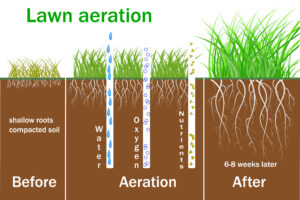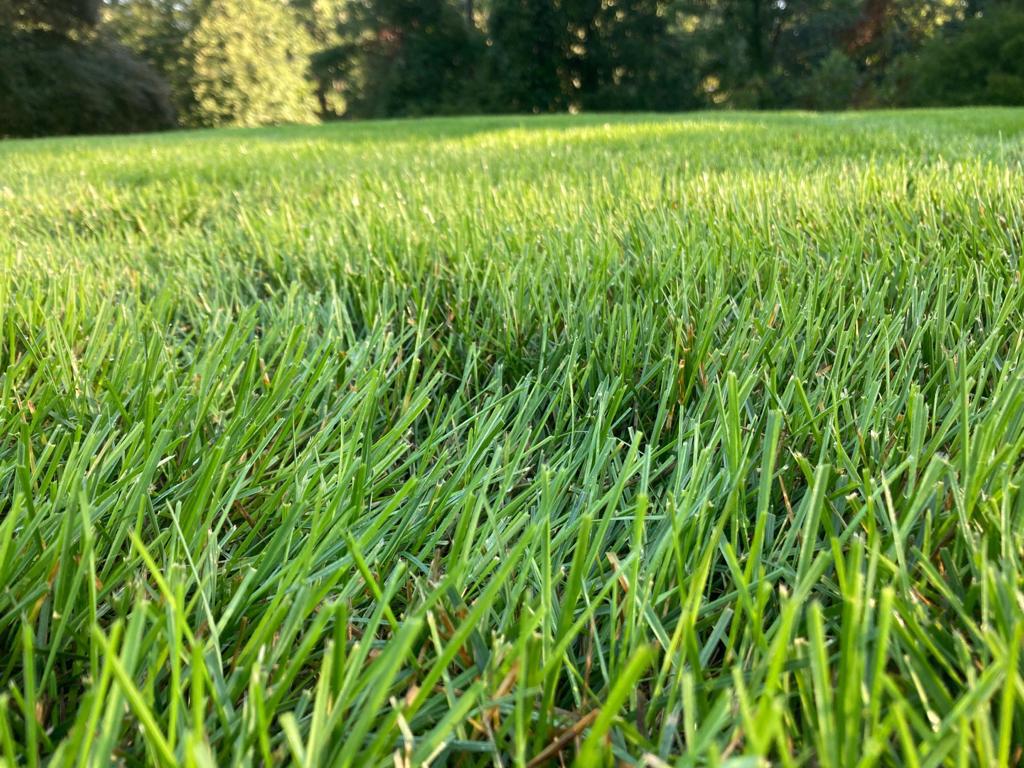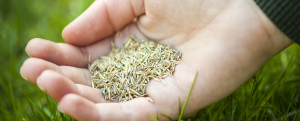About Premium Grass Aeration Service: Improve Your Lawn with Trusted Experts
Expert Grass Aeration Services for Healthy Lawns.
About Core Aeration
If you’ve ever seen a farmer plow a field, you’ve seen aeration in action. In short, “aeration” is the act of getting air down into the soil. Farmers figured out many centuries ago that loosening the soil and getting more air down to the root zone would benefit crops greatly. This simple truth has not changed, farmers still plow the fields every year before planting the crop.
Your lawn is not much different than a farmer’s crop. It is a large number of plants growing in a prepared soil base. With our aeration services, we don’t plow the grass because we would cause enough damage to need complete re-seeding. Instead, we use a core or lawn aerator, which has a similar effect with far less damage. We use advanced techniques to improve soil health by relieving compaction and enhancing nutrient absorption. Perfect for tackling patchy, thin grass or prepping your lawn for overseeding, our yard aeration services are tailored to give your grass the boost it needs to thrive. Let us help you achieve the stunning lawn you’ve always wanted—book your aeration service today!
What Is a Core Aeration?
Core aeration is a lawn maintenance practice that involves removing small plugs or “cores” of soil from the turf and lawn area. This process is carried out using a specialized machine called an aerator. A core aerator typically has a series of hollow tines or spikes that penetrate the soil and extract cylindrical soil plugs and thatch from the ground.

Benefits of Lawn Aeration
The primary purpose of aerating services is to alleviate soil compaction and improve the overall health of the lawn. Over time, soil compaction can occur due to foot traffic, heavy machinery, and natural settling. Compacted soil can lead to poor drainage, restricted airflow to the grass roots, and reduced nutrient absorption by the plants. Lawn aeration helps to address these issues by:
- Reducing Soil Compaction: Removing soil cores creates voids in the soil, allowing the remaining soil particles to loosen and expand. This enhances the movement of air, water, and nutrients throughout the soil profile.
- Improving Water Infiltration: Compacted soil often resists water absorption, leading to runoff and puddling. Core aeration enhances water infiltration, reducing the risk of waterlogged areas and promoting even moisture distribution.
- Stimulating Root Growth: Loosening the soil encourages healthier root growth. Roots can penetrate the soil more easily, leading to stronger, deeper root systems that can better access nutrients and water.
- Enhancing Nutrient Uptake: Improved soil structure allows nutrients to move more freely, making them more accessible to the roots of grass plants.
- Reducing Thatch Buildup: Thatch, a layer of dead grass and other organic matter can accumulate on the soil’s surface and hinder water and nutrient penetration. Core aeration helps break down thatch by mixing it with soil and promoting decomposition.
When is the Best Time to Aerate?
Grass aeration services are typically performed during the growing seasons, either in the spring or fall, when the grass is actively growing and can recover more quickly from the disturbance. The amount of disruption varies throughout the lawn, and it is not uncommon for us to get aggressive in the areas that need the most help to get new seed growing. After aeration, the extracted soil cores may be left on the lawn to break down naturally or distributed evenly using a drag mat.
Why Do We Sometimes Use a Drag Mat?
Using a drag mat during aeration helps distribute the soil cores and thatch pulled to the surface more evenly across the lawn. After core aeration, the extracted soil cores and any loose thatch are left on the lawn. These plugs and debris can create an uneven and unsightly appearance if concentrated in certain areas. By using a drag mat, also known as a drag harrow, you can achieve several benefits:
- Even Distribution: The drag mat helps break up the soil cores and thatch and distribute them evenly across the lawn. This prevents the buildup of soil cores in one area, creating a more uniform surface.
- Promotes Decomposition: Spreading out the soil cores and thatch encourages quicker decomposition. This is important because as these materials break down, they contribute nutrients back to the soil, helping to enrich the turfgrass.
- Minimizes Disruption: Using a drag mat minimizes the visible disruption caused by the aeration process. Instead of having scattered plugs and debris, the drag mat helps create a smoother appearance.
- Enhances Aesthetic Value: A properly used drag mat can improve the overall appearance of the lawn afterward. It creates a neater look that blends the soil cores and thatch with the surrounding turf.
- Improves Seed-to-Soil Contact: Using a drag mat can help create better seed-to-soil contact if overseeding is planned. This increases the likelihood of successful germination and establishment of new grass seed.
- Encourages Topdressing Penetration: If you plan to apply a topdressing of soil, compost, or other materials after aeration, a drag mat can help work these materials into the small holes and distribute them more evenly.
Using a drag mat in conjunction with core aeration can help maximize the process’s benefits and contribute to healthier, more attractive, and thicker lawn.
Seeding With Aeration
Seeding a lawn after aeration is a common practice known as overseeding. Core aeration and overseeding often go hand in hand, as they complement each other and can greatly improve the health and appearance of your lawn. Here’s how the process works:
- Core Aeration: Before overseeding, core aeration is beneficial to address soil compaction, improve soil structure, and create openings in the soil for new grass seeds to establish. This creates a favorable environment for seed germination and root growth.
- Selecting the Right Seed: Choose a grass seed blend appropriate for your climate, soil type, and lawn conditions. It’s often a good idea to select a mixture that includes a combination of grass species for better disease resistance, drought tolerance, and overall resilience.
- Timing: The timing of overseeding is crucial. The best time to overseed is during the growing season when the existing grass is actively growing, and the weather is conducive to seed germination. Early fall (late August to early September) is typically the optimal time in cool-season grass regions. In warm-season grass regions, late spring to early summer can be a good time for overseeding.
- Preparing the Area: Before overseeding, it’s a good practice to mow the existing grass slightly shorter than usual to allow sunlight to reach the soil. Raking or using a dethatching machine can help remove excess thatch that may inhibit seed-to-soil contact.
- Seeding: Use a broadcast spreader to spread the grass seed evenly over the lawn. To ensure good coverage, use a slightly higher seed rate for overseeding. To improve seed distribution, you can also mix the seed with a carrier material, such as compost.
- Topdressing: Applying a thin layer of topdressing material (like compost or screened topsoil) over the newly seeded area can help improve seed-to-soil contact and provide additional nutrients.
- Watering: Proper and consistent watering is crucial for seed germination and establishment. Keep the seeded area consistently moist, but avoid overwatering, which can lead to disease issues.
- Mowing: Once the new grass reaches a height of about 3 inches, you can start mowing. Gradually transition to regular mowing practices as the new grass becomes established.
Call Us Today to Schedule Your Grass Aeration Service
Aeration is the secret sauce to a lawn that’s as fluffy as a cloud and as vibrant as a rainbow! With our lawn aeration services, we’re not just poking holes in the ground – we’re giving your grass the VIP treatment it deserves. Say goodbye to compacted soil and hello to a healthy lawn that’s ready to party! So why wait? Let’s aerate, celebrate, and elevate your yard to superstar status. Because when it comes to your lawn, we’re not just aerating – we’re elevating!
Frequently Asked Questions
Should I Overseed after aeration?
Overseeding after core aeration helps introduce new grass plants into your lawn, filling in thin or bare areas and improving overall turf density. It’s a great way to rejuvenate a lawn and promote a lush, healthy, vibrant turf. Remember that results may vary based on grass type, weather conditions, and proper maintenance practices.
Can I do DIY grass aeration?
You can, but let’s be honest; aeration is not as simple as grabbing a garden fork and going to town on your lawn. Core aeration requires specialized equipment that pulls plugs of soil from the ground to relieve compaction appropriately. Professional grass aeration services can save you time and effort and take the guesswork out of the entire process, giving you the best lawn care with none of the hassle.
What is the difference between spike and core aeration?
Spike aeration uses solid tines to poke holes in the ground. Core aeration, on the other hand, removes small soil plugs, creating more space for air, water, and fertilizers to flow freely.
How can I prepare for my grass aeration service?
To prepare for your aerating service, consider taking the following steps:
- Mow your lawn slightly shorter than usual to help the aerator reach the soil
- Water your lawn a day or two in advance to soften the ground (but make sure it’s not overwatered or muddy)
- Mark any sprinkler heads and underground objects so they don’t get caught in the aerator
- Clear the yard of furniture, toys, and anything else that might get in the way
How should I care for my lawn after aeration?
To care for your lawn after grass aeration service and make sure it looks nice and healthy all season long, be sure to:
- Leave the soil plugs on the lawn to break down naturally and enrich the soil
- Overseed if you want to fill in bare spots and rejuvenate your lawn
- Keep the soil moist with regular watering
- Hold off on mowing for a few days to let the grass recover


